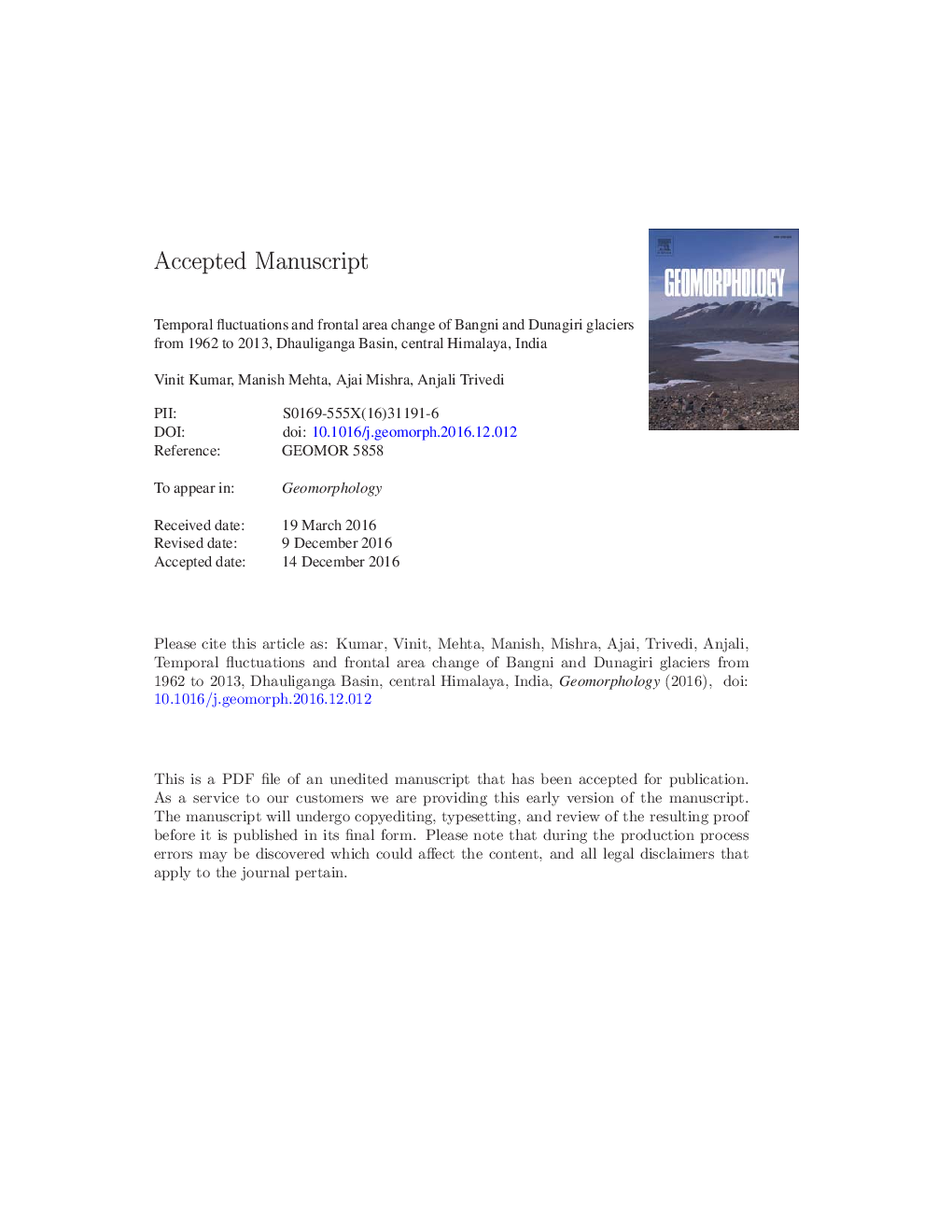| کد مقاله | کد نشریه | سال انتشار | مقاله انگلیسی | نسخه تمام متن |
|---|---|---|---|---|
| 5781099 | 1635365 | 2017 | 45 صفحه PDF | دانلود رایگان |
عنوان انگلیسی مقاله ISI
Temporal fluctuations and frontal area change of Bangni and Dunagiri glaciers from 1962 to 2013, Dhauliganga Basin, central Himalaya, India
دانلود مقاله + سفارش ترجمه
دانلود مقاله ISI انگلیسی
رایگان برای ایرانیان
کلمات کلیدی
موضوعات مرتبط
مهندسی و علوم پایه
علوم زمین و سیارات
فرآیندهای سطح زمین
پیش نمایش صفحه اول مقاله

چکیده انگلیسی
Glaciers have been receding for the last 100 years in many glaciated regions of the world, and the rate of recession has accelerated during the last 60 years. Recent assessments of changes in glaciers in the Himalaya have usually recognized their variable rate of recession. The present study deals with snout retreat, frontal area vacation, and estimation of the equilibrium line altitude (ELA) of Bangni and Dunagiri glaciers, in the Dhauliganga Basin, central Himalaya (India), using multi-image satellite data (Landsat MSS, 1976; Landsat TM, 1990; Landsat ETM +, 2005) and Survey of India topographic maps (1962; 1:50,000) along with field surveys (2012 to 2014) for the period of 1962-2013. The meteorological data of the India Meteorological Department (IMD) and TRMM suggested that the central Himalaya received less precipitation between 1960 and 1990. Because of the less precipitation, glaciers receded rapidly during this period. The present study shows that Bangni and Dunagiri glaciers retreated ~ 2080 ± 162 m and ~ 484 ± 38 m with average rates of ~ 41 ± 3.2 m aâ 1 and ~ 9 ± 0.6 m aâ 1 between 1962 and 2013, respectively. During this period Bangni and Dunagiri glaciers lost about 17% and 11% of their length, respectively. The result also suggested that Bangni Glacier vacated ~ 598,948 ± 12,257 m2 frontal area, while Dunagiri Glacier vacated ~ 170,428 ± 7833 m2 frontal area between 1962 and 2013. Moreover, the estimated ELA change for Bangni Glacier was ~ 64 ± 30 m upward during the study period. The Geological Survey of India (GSI, 1998a,b) suggested that the ELA of Dunagiri Glacier rose ~ 28 m between 1984 and 1992 and that the glacier lost ~(â)16 Ã 106 m3 w.e. ice with an average rate of loss of ~(â)1.04 m w.e. aâ 1. The geomorphology of the Dunagiri Valley reflected that Bangni and Dunagiri glaciers were joined together in the past. Nevertheless, these two glaciers retreat at different rates, indicating that climate change is not the only factor in glacier retreat but that geometry (size, shape, slope, and orientation) of the glacier and basin topography also plays a major role.
ناشر
Database: Elsevier - ScienceDirect (ساینس دایرکت)
Journal: Geomorphology - Volume 284, 1 May 2017, Pages 88-98
Journal: Geomorphology - Volume 284, 1 May 2017, Pages 88-98
نویسندگان
Vinit Kumar, Manish Mehta, Ajai Mishra, Anjali Trivedi,